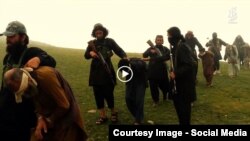KABUL, Afghan lawmaker Haji Zahir Qadir has offered a scathing criticism of his government’s claim that its forces have made significant progress in preventing the Islamic State (IS) from establishing a foothold in eastern Afghanistan.
Qadir, deputy speaker of Olasi Jiga, the popularly elected lower house of Afghan Parliament, told lawmakers on July 18 that Afghan forces have so far failed to root out IS militants from rural districts in eastern Nangarhar Province, where the group overran at least six districts bordering Pakistan last summer.
“For example, we have one district by the name of Haska Maina -- we only control the government compound in the district center,” he said. “Why is no one accepting this reality?”
Qadir, who represents Nangarhar in Olasi Jirga, said at least 50 Uighur families from the northwestern Xinjiang region in China are currently living in Haska Maina.
“Whenever the government attacks them, the IS fighters retreat into the mountains, but they always return once the forces have left,” he said. “We have made no advances and have not reclaimed any lost territory.”
Qadir didn’t elaborate on the threat posed by Uighur fighters. But the hard-line East Turkistan Islamic Movement reportedly had close contacts with the Islamic Movement of Uzbekistan (IMU) and other Central Asian extremist factions.
These groups were headquartered in Pakistan’s western tribal areas on the Afghan border for more than a decade after the demise of the Taliban regime in late 2001. The Taliban hosted Al-Qaeda, the IMU, and allied jihadist factions from across the Muslim world.
A large-scale Pakistani military operation in 2014 pushed most of these militants into Afghanistan, where many pledged allegiance to IS. This provoked a violent Taliban reaction. In November the Taliban claimed to have killed a large number of IMU followers, a sizeable number of the remaining militants appear to have joined IS.
Local affiliates of the ultra-radical IS, locally known by its Arabic acronym Daesh, first emerged in Nangarhar in late 2014 soon after the main IS organization established control over large swathes of Syria and Iraq.
Extreme violence against civilians, rival militant factions, and security forces marked IS's rapid rise in Nangarhar last year.
The atrocities provoked a local rebellion against IS. Qadir’s loyalists beheaded some IS loyalists and publicly displayed their severed heads in December.
Since January, U.S. air strikes helped Afghan forces to reclaim some Nangarhar regions from IS.
Last week, General John Nicholson, the top U.S. commander in Afghanistan, said the IS presence in Nangarhar has shrunk considerably. He told journalists that IS now present in just three districts down from nine last year.
During a brief visit to the Afghan National Army’s 201 Selab Corps in Nangarhar on July 16, Afghan President Ashraf Ghani vowed to eradicate IS.
“I want to announce from this platform that the brave Selab Army Corps will destroy Daesh within a few weeks,” he told Afghan troops.
Dawlat Waziri, a spokesman for the Afghan Defense Ministry, rejected Qadir’s claims and said IS forces have been beaten back in most Nangarhar districts.
“We are determined to finish them off soon,” he said.
Abubakar Siddique wrote this story based on Rahmatullah Afghan’s reporting from Kabul, Afghanistan.








